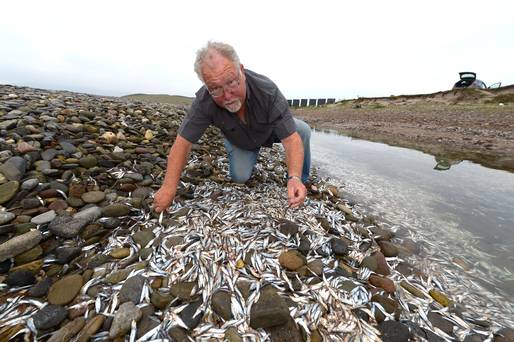
The phenomenon has never been seen in the area before, at least not in such huge numbers, but experts believe it is a natural occurrence that may be related to the fine weather over the past few weeks.
The fish are mainly sprat but there are also mackerel among the decaying bodies on the shore that will now have to be disposed of by Kerry County Council.

Locals contacted fisheries expert, Kevin Flannery, the director of Dingle's Oceanworld Aquarium and the go-to man for all matters marine.
He believes one of two things happened; either the fish were chased ashore by something in the water or else it was caused by a tidal bloom.
"Either they were being chased by bigger fish like blue fin tuna or a shoal of mackerel and got trapped in the corner of the bay and got washed ashore," he said.
"The other possibility is that because of the fine weather there are a lot of tidal blooms and Noctiluca or night light occurs where the plankton in the water lights up by night.
The phenomena of Noctiluca scintillans is also known as sea sparkle. It causes fluorescent blue patches that glimmer in the water and although it can look magnificent, it can also be potentially toxic.
Sea sparkle can also be triggered by pollution from sources like farm waste where an increase in nitrogen and phosphorus cause the plankton to bloom.
"It's a beautiful thing to see and not something that occurs too often," Mr Flannery added.
"With the prevailing southeasterly winds the plankton would have accumulated in the harbour but it would also deplete the oxygen in the water."
And if the oxygen is depleted in the water, the fish are also starved of air and die.
"Birds are very sensitive and like to catch their fish alive but because of the way they die, the birds won't touch them," he said.
"The problem is that scavengers are not eating then either so now they're just rotting on the beach so the council will have to bury them."
Mr Flannery also believes the fish came in in one wave and all came ashore at the same time.
He's also getting reports of similar occurrences all along the coast of Tralee Bay up as far as Fenit.
An abundance of fish in the water has also attracted humpback whales to waters off the southwest coast.
A school of about 20 humpbacks have been seen off the coast of Valentia in south Kerry and were first spotted on Tuesday by boatmen going to Skellig Michael before the season closed on September 30.
The whales are 'bubble netting' in waters off the coast and the fish they're catching are also attracting other creatures including dolphins and gannets.
The humpbacks have also been spotted as far up the coastline as Ballydavid in west Kerry.



Reader Comments
to our Newsletter